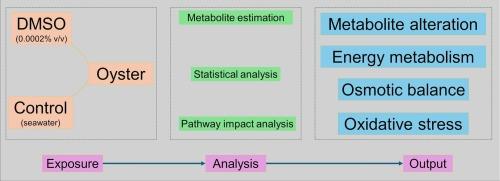A metabolomic analysis on the toxicological effects of the universal solvent, dimethyl sulfoxide
IF 4.3
3区 环境科学与生态学
Q2 BIOCHEMISTRY & MOLECULAR BIOLOGY
Comparative Biochemistry and Physiology C-toxicology & Pharmacology
Pub Date : 2024-11-08
DOI:10.1016/j.cbpc.2024.110073
引用次数: 0
Abstract
Dimethyl sulfoxide (DMSO) is a solvent used to dissolve a variety of organic compounds. It is presumed to be non-toxic at concentrations below 1 % v/v, although several studies have demonstrated that low dose DMSO exposure can alter cellular biochemistry. This study evaluated the toxicity of DMSO at 0.0002 % v/v to the Sydney Rock oyster, Saccostrea glomerata, following 7d of exposure. Metabolites were chosen as the toxicity endpoints because they can be used as energy sources and counteract contaminant-induced stress. Relative to seawater controls, exposure to DMSO caused a 74 % significant change in metabolites in the female digestive gland, including decreases in most amino acids, carbohydrates, nicotinamides, and lipids. The female gonad showed a 43 % significant change in metabolites, with decreases in amino acids and carbohydrates, but increases in lipids. The male digestive gland showed a 29 % significant change in metabolites, with increases in lipids. The decline in metabolites in the female digestive gland, but not in the male digestive gland, may be due to their differential metabolic demands. Furthermore, pathway impact analysis revealed that DMSO exposure altered energy metabolism, disturbed osmotic balance, and induced oxidative stress in oysters. Because the effects of DMSO are not uniform across gender and tissue, use of DMSO as a solvent will confound metabolomic experimental results when comparisons among sexes and/or tissues are integral to the experimental design. There is a risk of incomplete dissolution of contaminants unless carrier solvents are used. Therefore, in practice, a solvent control along with a water control is recommended for experimentation.

对通用溶剂二甲基亚砜毒理效应的代谢组学分析。
二甲基亚砜(DMSO)是一种用于溶解多种有机化合物的溶剂。据推测,浓度低于 10 % v/v 的二甲基亚砜是无毒的,但有几项研究表明,低剂量接触二甲基亚砜会改变细胞的生物化学特性。本研究评估了浓度为 0.0002 % v/v 的二甲基亚砜在悉尼岩牡蛎(Saccostrea glomerata)接触 7 天后的毒性。之所以选择代谢物作为毒性终点,是因为代谢物可用作能量来源并抵消污染物引起的压力。与海水对照组相比,暴露于二甲基亚砜会导致雌性消化腺代谢物发生 74% 的显著变化,包括大多数氨基酸、碳水化合物、烟酰胺和脂类的减少。雌性性腺的代谢物发生了 43% 的显著变化,氨基酸和碳水化合物减少,但脂类增加。雄性消化腺的代谢物有 29% 的显著变化,脂类增加。雌性消化腺中的代谢物减少,而雄性消化腺中的代谢物没有减少,这可能是由于它们的代谢需求不同造成的。此外,路径影响分析表明,暴露于二甲基亚砜会改变能量代谢,破坏渗透平衡,并诱发牡蛎的氧化应激。由于 DMSO 对不同性别和不同组织的影响不尽相同,因此,当性别和/或组织间的比较是实验设计的组成部分时,使用 DMSO 作为溶剂会混淆代谢组学实验结果。除非使用载体溶剂,否则存在污染物溶解不完全的风险。因此,在实际操作中,任何实验都建议使用水对照和溶剂对照。
本文章由计算机程序翻译,如有差异,请以英文原文为准。
求助全文
约1分钟内获得全文
求助全文
来源期刊
CiteScore
7.50
自引率
5.10%
发文量
206
审稿时长
30 days
期刊介绍:
Part C: Toxicology and Pharmacology. This journal is concerned with chemical and drug action at different levels of organization, biotransformation of xenobiotics, mechanisms of toxicity, including reactive oxygen species and carcinogenesis, endocrine disruptors, natural products chemistry, and signal transduction with a molecular approach to these fields.

 求助内容:
求助内容: 应助结果提醒方式:
应助结果提醒方式:


